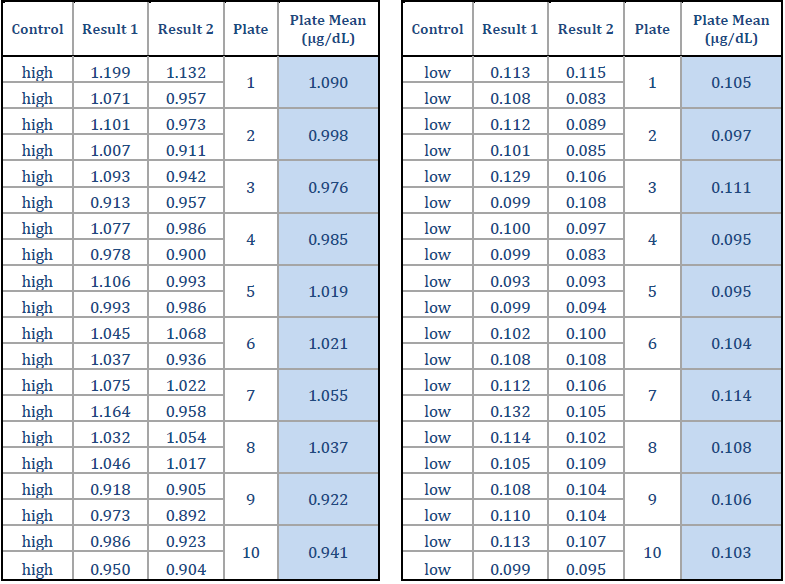Spit tips
Inter- and Intra-Assay Coefficients of Variability
In order to express the precision, or repeatability, of immunoassay test results, researchers in the social and behavioral sciences typically report two measures of the Coefficient of Variability (CV) in their publications: the Inter-Assay CV and the Intra-Assay CV. The CV is a dimensionless number defined as the standard deviation of a set of measurements divided by the mean of the set. Since the usage of the term intra-assay CV may vary somewhat between fields of study, some clarification of terminology and methods is in order.
In larger studies with many samples to be tested, it is necessary that samples be run on multiple assay plates. Each plate is run with its own calibrators for the standard curve, and saliva controls with known concentrations of the analyte–usually a high and a low value–are also included on each plate. The inter-assay CV is an expression of plate-to-plate consistency that is calculated from the mean values for the high and low controls on each plate, as illustrated in Example 1 below (taken from internal Salimetrics data).Most studies measure each sample in duplicate for each analyte. The degree to which the duplicate results differ can be expressed by calculating the standard deviation of the two results and converting it to the CV. Testing each sample with greater numbers of replicates would produce statistically better results for the standard deviation and calculation of the CV, but this practice would be prohibitively expensive for large studies. The intra-assay CV reported in these studies is an average value calculated from the individual CVs for all of the duplicates, even if the total number of samples requires the use of multiple assay plates. (1) An illustration of the calculation of the intra-assay CV from 40 samples (using internal Salimetrics data) is provided in Example 2.
Salimetrics offers the following comments on calculating and interpreting CVs:
- CVs should be calculated from the calculated concentrations rather than the raw optical densities.
- Inter-assay % CVs of less than 15 are generally acceptable.
- Intra-assay % CVs should be less than 10.
- These scores reflect the performance of the assay in the hands of the user; they are not the same as the measures used by the assay manufacturer to insure consistency in the manufacturing process.
- It is important that the CVs are reported for concentrations that reflect the range of results found in the specimens.
It is important that the CVs are reported for concentrations that reflect the range of results found in the specimens.
Experimental results with poor intra-assay CVs (>10%) frequently reflect poor pipetting technique on the part of laboratory technicians. (1) In addition, mishandling due to the high viscosity of saliva can make pipetting especially difficult. Salimetrics recommends freezing each sample once, followed by vortexing and centrifugation, which will help precipitate and remove mucins. Pre-wetting each pipette tip in the solution to be pipetted will also help improve CVs. (Remember to change tips between each sample, standard, or control.) Pipettes must also be properly calibrated and maintained for best results. For a discussion of the importance of proper pipetting, see the article Assay Variance and Control found in this newsletter, and follow these links to related articles from pipette manufacturers. (2-6)
Experimental results with poor intra-assay CVs (>10%) frequently reflect poor pipetting technique on the part of laboratory technicians. (1) In addition, mishandling due to the high viscosity of saliva can make pipetting especially difficult. Salimetrics recommends freezing each sample once, followed by vortexing and centrifugation, which will help precipitate and remove mucins. Pre-wetting each pipette tip in the solution to be pipetted will also help improve CVs. (Remember to change tips between each sample, standard, or control.) Pipettes must also be properly calibrated and maintained for best results. For a discussion of the importance of proper pipetting, see the article Assay Variance and Control found in this newsletter, and follow these links to related articles from pipette manufacturers. (2-6)
Example 1. Calculating Inter-Assay CV: The Average Coefficient of Variation from Plate Control Means.
In this example the same high and low cortisol controls are run in quadruplicate on ten different plates to monitor plate-to-plate variation. The plate means for high and low are calculated and then used to calculate the overall mean, standard deviation, and % CV. Overall % CV = SD of plate means ÷ mean of plate means x 100. The average of the high and low % CV is reported as the inter-assay CV.

Example 2. Calculating Intra-Assay CV: The Average Coefficient of Variation between Duplicates.
In this example cortisol concentrations are measured in duplicate for 40 samples. The % CV for each sample is calculated by finding the standard deviation of results 1 and 2, dividing that by the duplicate mean, and multiplying by 100. The average of the individual CVs is reported as the intra-assay CV.

References
1. Schultheiss, O.C., Stanton, S.J. (2009). Assessment of salivary hormones. In: Harmon-Jones, E., Beer, J.S., eds. Methods in Social Neuroscience. New York: Guilford Press.
2. Mannonen, S., Tiusanen T., Suovaniemi, O. (2000). Major sources of error of air displacement pipettors. Biohit. PDF
3. Ylätupa, S. (1996). Optimizing your pipetting performance. Biohit. PDF
4. Mannonen, S., Nieminen, P. Kaasinen, J., Andersin, K. (2006). Raising the standard of mechanical pipetting. Biohit. PDF
5. Hemmings, I. (2009). The importance of regular in-lab checking of pipettes. Biohit. PDF
6. https://www.fisher.co.uk/techzone/pdfs/pipetting_techniques.pdf